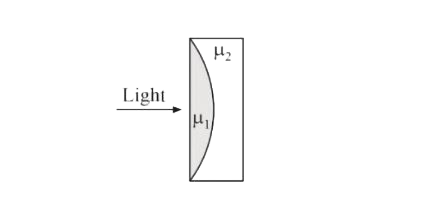There is an equiconcave glass lens with radius of each face as R and .aμg=3/2 and .aμW=4/3 . If there is water in object space and air in image space, then the focal length is
2 R
R
3R/2
R2
The correct Answer is:c
Step by step video, text & image solution for There is an equiconcave glass lens with radius of each face as R and ._(a)mu_(g) = 3//2 and ._(a)mu_(W) = 4//3 . If there is water in object space and air in image space, then the focal length is by Physics experts to help you in doubts & scoring excellent marks in Class 12 exams.
Updated on:21/07/2023Topper's Solved these Questions
- RAY OPTICSBOOK - ERRORLESS CHAPTER - RAY OPTICSEXERCISE - Refraction of Light at Plane Surfaces
9 Videos
- RAY OPTICSBOOK - ERRORLESS CHAPTER - RAY OPTICSEXERCISE - Refraction at Curved Surface
8 Videos
- MAGNETISMBOOK - ERRORLESS CHAPTER - MAGNETISMEXERCISE - Assertion & Reason
1 Videos
- WAVE OPTICSBOOK - ERRORLESS CHAPTER - WAVE OPTICSEXERCISE - SET
23 Videos
Similar Questions
A plano convex lens fits exactly into a plano concave lens. Their plane surfaces are parallel to each other. If lenses are made of different materials of refractive index μ1=4/3 and μ2=6/5 and R = 40 cm is the radius of curvature of the curved surface of the lenses, then the focal length of combination (in meters) is.

View SolutionThe deviation produced by a thin glass prism placed in air, when immersed in water is
[Given aμg=3/2andaμw=4/3]
View Solution
Knowledge Check
An equi-convex glass lens with radius of each face as R is placed in air (.aug=3/2). "If there is water in the object space and air in the image space and given" .auw=4/3, the focal length of the lens is
A4 RB2 RC3R2DRIn the above question if there is air in the object space and water in the image space, then the focal length is
A4 RB2 RC3R2DRaμg=32 and aμw=43. If the speed of light in glass is 2.00×108 m/s the speed in water will be
A2.67×108 m/sB2.25×108 m/sC1.78×108 m/sD1.50×108 m/s
The ratio of angle of minimum deviation of a prism in air and when dipped in water will be (.aμg=3/2and.aμw=4/3)
View SolutionA thin prism of glass is placed in air and water successively. If aμg = 32 and a aμw =43, then the ratio of deviations produced by the prism for a small angle of incidence, when placed in air and water is?
View SolutionA ray of light propagates from glass (aμg=1.5) to water ('aμw43) . The value of critical angle is
View SolutionA ray of light propagates from glass (aμg=1.5) to water (aμw43). The value of critical angle is
View SolutionA plano-convex lens has focal length of 20 cm. the radius of its spherical suface is (aμg=1.5)
View Solution
